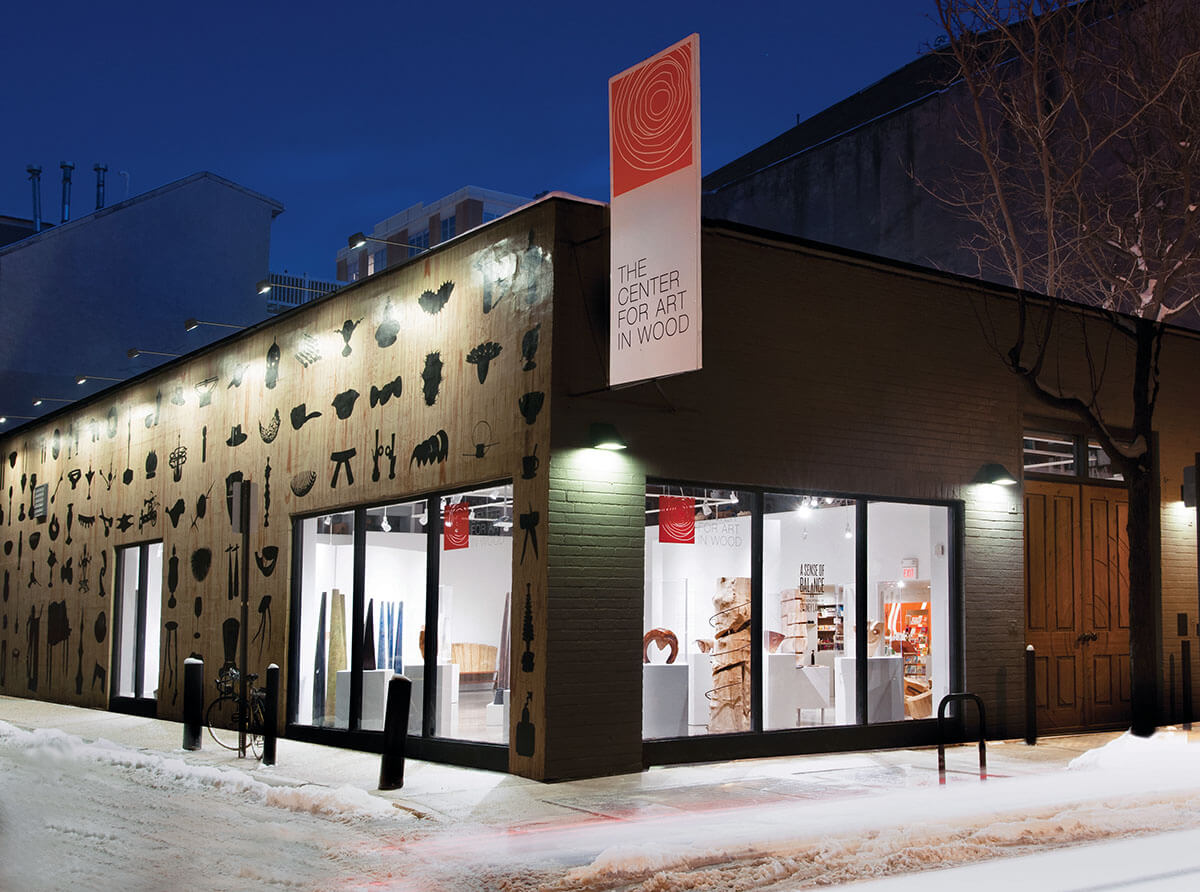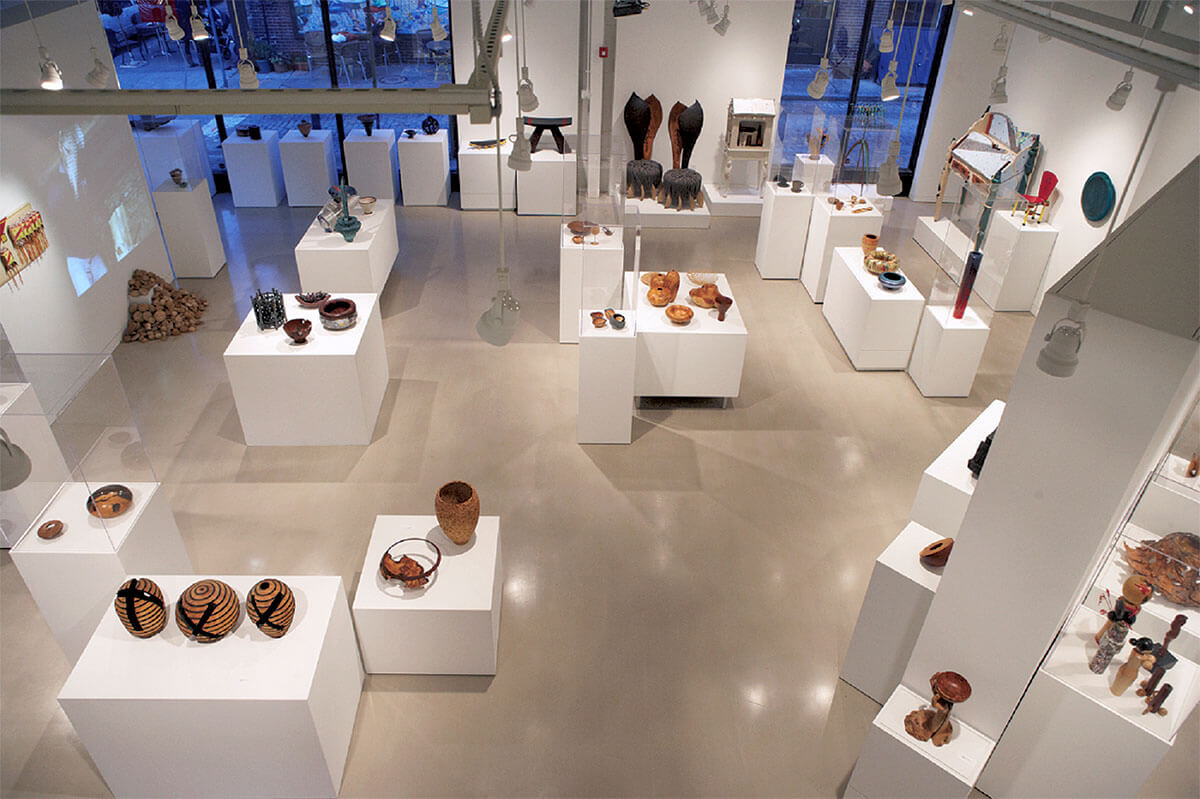The Center for Art in Wood
VISION INTO ART
In 1981 as part of the tenth and final symposium held at Bucks County Community College, Albert organized the ground-breaking touring exhibition, The First North American Turned Object Show, and accompanying publication, A Gallery of Turned Objects. Immediately following, the work was displayed in joint exhibits at the Richard Kagan Gallery and Works Gallery in Philadelphia. Setting early precedents, the exhibit toured nationally to five venues.
Effective November 14, 1986, the LeCoff brothers incorporated the Wood Turning Center as a 501(c)(3). Albert became Executive Director, a post he still holds as the Center approaches its 30th anniversary in 2016.
Albert’s initial passion for wood turning became his life’s work. In 1988, he organized the first international exhibition of lathe-turned objects. Entitled the International Turned Objects Show (ITOS), the exhibition and concurrent color publication, Lathe-Turned Objects: An International Exhibition, would be one of the many Center exhibits to tour nationally. ITOS reached many general audiences who awoke for the first time to the art and beauty of objects made from chunks of wood. In appreciation, thirty-five international artists made LeCoff a stunning collection of walking canes, now known as the Albert LeCoff Tribute Cane Collection.
Other firsts included two international gatherings, the 1993 and 1997 World Turning Conferences. Held respectively at the Hagley Museum & Library and Winterthur Museum & Gardens in Wilmington, Delaware, these events featured lectures and wood turning demonstrations. Historical and contemporary topics are documented in illustrated conference papers and the Center’s archives.
By 2001, the Center was collaborating with the Yale University Art Gallery to research, stage and document Wood Turning in North America Since 1930. This extensive survey of wood-turned art traveled from the Minneapolis Institute of Arts; to the Smithsonian American Art Museum, Renwick Gallery; to the Yale University Art Gallery. The accompanying color publication soon became a touchstone of documentation and 20th century craft context.
In 2003, the American Craft Council (ACC) recognized Albert LeCoff as an ACC Honorary Fellow for his undaunting dedication, passion and prolific service to the field of art made from wood. With staff, Albert has organized over 50 exhibitions, and published over 20 books focused on wood art. The Center stands as an invaluable resource for artists, educators, curators, students, collectors and the general public.
As Elisabeth R. Agro of Philadelphia Museum of Art states in Turning to Art in Wood: A Creative Journey (2011), “Wood turning was a latecomer to the field of contemporary craft. Much of the significance that surrounds the field of art in wood is in large part due to Albert LeCoff’s devotion to and promotion of this art form and his unwavering vision for the Center, and steadfast engagement with collectors and museums. By merging centuries-old wood turning tradition with the application of age-old and new techniques to traditional and uncommon materials; and establishing a network between artists, collectors, scholars and museums, the Center was the catalyst for catapulting the field into the art arena and onto the national stage.”

The Center for Art in Wood exterior. Written in Wood mural by Benjamin Volta (left); AT THE CENTER delivery doors designed by Gord Peteran (right)
MILESTONES FOR THE CENTER
- 1986–1991 — Wood Turning Center operated from Albert LeCoff’s home at W. Washington Lane in Germantown, Philadelphia, Pa
- 1991–2000 — Wood Turning Center relocated and operated from Albert and Tina LeCoff’s home at W. Coulter Street in Germantown, Philadelphia
- September 2000 — Wood Turning Center relocated to a public facility at 501 Vine Street, Old City, Philadelphia
- September 2004 — Wood Turning Center doubled its space at 501-505 Vine Street, Old City, Philadelphia
- Major changes occurred in 2011—
- The Center changed its name to The Center for Art in Wood to reflect its evolution into a nonprofit that fosters and presents the broad range of art that artists make from wood, and wood in combination with other materials. Artists continually expand their creativity and physical expertise, and that in turn constantly informs and inspires the Center’s mission and programs.
- The Center moved to a larger building at 141 N. 3rd Street in the heart of the Old City Philadelphia arts and culture district.
- Visitation increased to 14,000 the first year after relocation.
- To celebrate its 25th anniversary in the same year, the Center published Turning to Art in Wood: A Creative Journey. This large format portfolio, with essays and color plates, along with an accompanying exhibition, feature a large sample of the Center’s Museum Collection.
- In this busy location, the Center holds continual exhibitions in the Gerry Lenfest Gallery, the Museum Collection, the Fleur and Charles Bresler Research Library, the Earl Powell Artist Files, the Len Scherock Museum Store, and the Windgate ITE
International Residency program.
MISSION
The Center for Art in Wood will continue to be the preeminent arts and education organization advancing the growth, awareness, appreciation and promotion of artists and the creation and design of art in wood, and wood in combination with other materials.
ART IN WOOD: PHILADELPHIA’S ACC FELLOWS
In early 2015, to learn more about the Philadelphia-region ACC Fellows who work in wood, Albert and I paid several visits to the artists in their studios. Interviews included experiences, past and present that shaped the artists’ lives and careers, as well as examinations of innovative bodies of work that span thirty to forty year careers. Albert focused on selecting artwork for the installation at The Center for Art in Wood, while my essays capture these special visits. Clearly each fellow is an ambassador for the Philadelphia region, and the community of art and artists within which their careers thrive.
Glenn Adamson provides a good summary from the helicopter of the long-term impacts of the Center, writing in Turning to Art in Wood: A Creative Journey: “Craft in general derives its potency from the specificity of tools, materials, and processes, all worked out over many years and by many hands. The same is true of the Wood Turning Center [now The Center for Art in Wood]. You never quite know what you’ll get from this little dynamo of an organization. It may never be a large and powerful organization, but it will always be an interesting one; and that’s what really counts.”
—Tina C. LeCoff

Installation: Turning to Art in Wood A Creative Journey, in the Gerry Lenfest Gallery.
